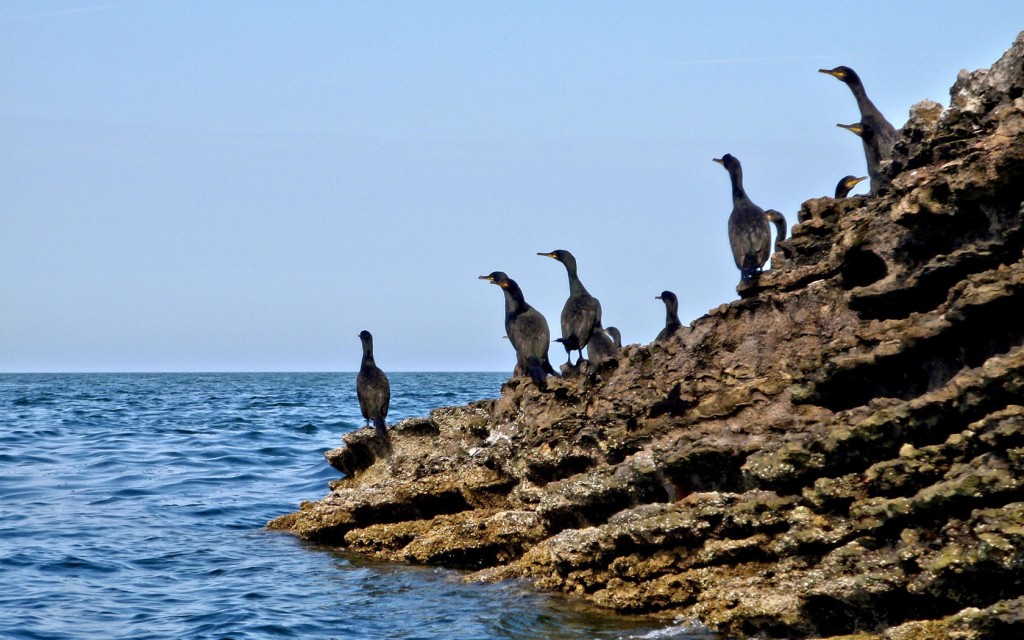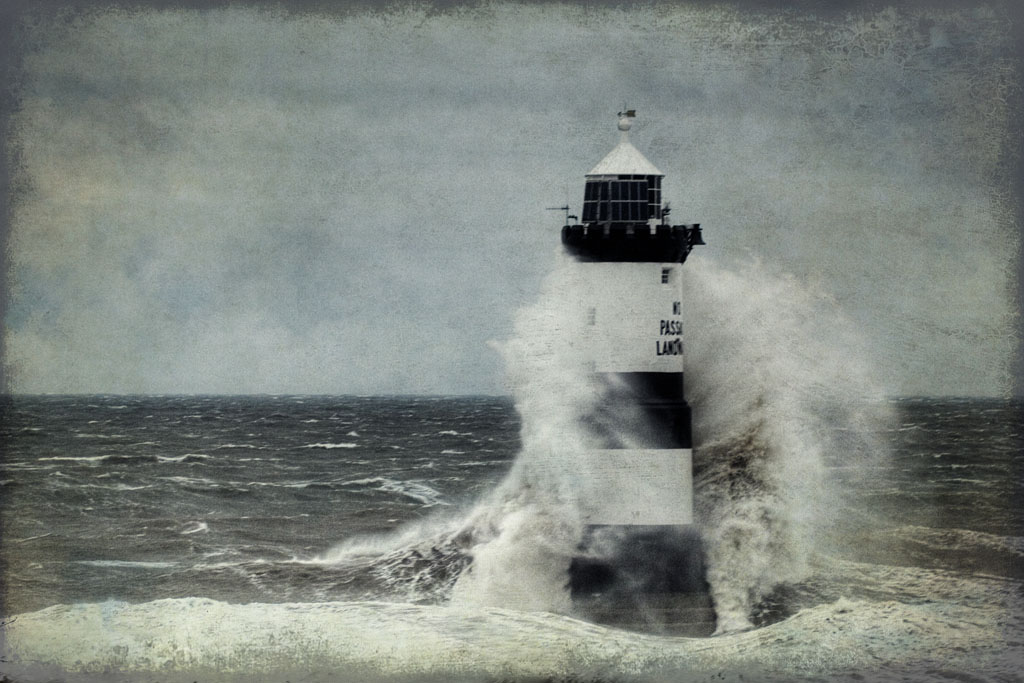
With thanks to Dav Thomas Also see his website
Penmon is located at the North East end of the Island of Anglesey. During the 6th Century many monasteries were formed in remote corners of the Celtic world. Two of these monasteries were formed at the opposite end of Anglesey; St Cybi in Holyhead and St Seiriol at Penmon. Legend has it that the two saints would walk to Llanerchymedd, in the centre of Anglesey, for a weekly meeting. St Cybi faced the rising sun in the morning, and setting sun in the evening while Seiriol always had the sun on his back. This gave rise to the names Seiriol Wyn and Cybi Felyn (Seiriol the Fair and Cybi the Dark) as only Cybi became tanned.
Penmon
Photographic opportunies
- There is an interesting range of buildings at Penmon (see below)
- Quarries at Flagstaff, Dinmor and Marble Quarry
- Derelict buildings
- Black Point, Penmon lighthouse, Puffin Island, Lightkeeper’s cottages, Lifeboat shed
- Pleasant walk from car park to Black Point
- Footpaths through Penmon Park (old Monastic lands), some of the high walls originally built to contain the deer still exist today.
Special Photographic Features or notes
St Seiriol’s Well
Possibly the oldest structure is St Seiriol’s Well, enclosed within a small building close to the Priory. Many early Celtic churches were associated with holy wells, believed to have healing powers and were often visited by pilgrims; beliefs that were probably carried over from pre Christian Celtic religions. The path to the well passes the fish pond that the monks had built.
The building around the well now is probably an 18th Century construction, and not as old as the floor and lower parts of the well.
Penmon Priory
The monastery at Penmon evolved through the centuries, and by the 10th Century had a wooden church building with two high crosses that had most likely stood at the entrance to the monastic grounds. Viking raids in 971 destroyed this church, which was rebuilt in stone during the 12th century to give the current building.
The church is of a cruciform arrangement. The nave (oldest part) having been completed about 1140. The tower and transepts followed in 1160-70 with the chancel added in 1220-1240. There was also a refectory built around this time, but that three storey building is now roofless.
In keeping with most other monasteries, this one was dissolved in 1537 during the reign of Henry VIII. The lands passed into ownership of the local landowners, the Bulkley family, and were subsequently used as a deer park.
Across the road from the Priory is a walled orchard, the entrance of which is almost concealed by two gnarled trees

The church is still in use, and much of it was rebuilt in 1855.
High Crosses
The high crosses from the entrance to the medieaval monastery are now housed within the church. The carvings on the crosses are now barely visible.There is a baptismal font, also within the church, that might have been the original base for the smaller of the two crosses.
Dovecote
This was probably built by Sir Richard Bulkley in around 1600, following his acquisition of the old monastery land. It housed domestic pigeons, kept for their eggs and meat.
Puffin Island
At the time that he founded the Penmon Monastery, St Seiriol also set up a community on the small island just off the coast, known in English as Puffin Island, in Welsh as Ynys Seiriol and known by the Vikings as Priestholm.
There are a number of ruins of medieaval monastic buildings on the island, which include the tower of a 12 century church. St Seiriol is possibly buried there, as might be King Maelgwn Gwynedd, a ruler of North Wales and St Seiriol’s patron. Puffin Island was home to a large colony of seabirds, but in the 1890s brown rats found their way to the island and decimated the bird population. The Countryside Council of Wales began a programme in 1998 to try and rid the island of rats, to hopefully enable the birds to return.
Puffin Island is not open to the public, and access is only by the sea and with permission from Baron Hill Estates. There are numerous boat trips from nearby Beaumaris that go around the island, and that is main way that photographers can capture some of the seabirds and seals that can be found there
Penmon Lifeboat
The sound between the island and Black Point is treacherous, and on 17th August,1831 a boat on a day trip from Liverpool – The Rothesay Castle was wrecked on the Dutchman’s Bank. Only 23, out of the 140 who had been on board were saved.
This disaster resulted in the opening of a lifeboat station at Penmon in 1932. The lifeboats from this station launched 65 times on service, and were responsible for saving 143 lives. The establishment of a motor lifeboat station in nearby Beaumaris signalled the end for the Penmon lifeboat, with the “Christopher Brown” withdrawn from service at the end of March 1915.
Penmon Lighthouse
Established in 1838, and autmated in 1922 the Penmon Lighthouse stands 29m high. Very photogenic, with so many different moods.
Best time of Year or Day
I would be incined to say anytime.
Dawn at Penmon
Dawn, with the sun rising above the Great Orme and/or Puffin Island can result in nice images. You need to get there in plenty of time to choose your vantage point and image composition. I have found that climbing up onto the high ground to the left of the road allows you to get a wide view of the area. Some people, as in image below, choose to get very close to the lighthouse for the picture.

Closer view and Wider angle view
Daytime at Penmon
Sunset or evening
Evening at Penmon isn’t the easiest to capture. If the tide is low enough, then getting on the beach can mean that you can get the lighthouse and sunset in the same shot. The image below is of the sun setting over the sea. Dinmor Quarry is located in the headland to the extreme left of the shot.

This beautiful evening shot was taken by Meirion Matthias
Night Photography
Not particularly my thing, but I am lucky to have photographer friends that are really into the night time.
The image above was my first attempts at night photography. Long exposure on a moonlit night.
The following shows what can be achieved at night time Penmon.

By Carl Jones, moonlit Penmon. Original can be seen here
Wild Seas
North wind just after high tide. Taken with a zoom lens.
More images can be seen at Black Point
Quarrying at Penmon
Visible from the road to Penmon is the Flagstaff Quarry, accessible by a walk along the beach. There are ruined quarrying buildings on the shore near farm. A second quarry Dinmor, now a fish farm, is located on opposite side of headland, turn left off road to Penmon Point. The grey/brown veined limestone that was quarried here was known as Penmon Marble. Penmon provided some of the limestone was used to build Birmingham Town Hall and help with the reconstruction of Liverpool and Manchester following the destruction caused in the Second World War.The stone was also used in the construction of the Menai Suspension Bridge that was completed in 1826, and the Britannia Bridge that was completed in 1850.
Special Equipment/Considerations
There are a few bits of special equipment that might be needed in this area.
- Footwear I would recommend sturdy footwear for the beach as the seaweed covered rocks can get pretty slippery, ordinary footwear fine at Priory area. Appropriate clothing for the weather.
- Tripod. Essential for the interior shots, and helpful for the landscape shots too.
- Extra lens cleaning cloths I always tend to carry cleaning cloths. The weather is unpredictable to say the least and the spray off the sea in wild weather makes cleaning equipment essential, and waterproof cover ideal.
- Wide angle lens I would take a range of lenses, but think that as wide an angle as possible is a must to really capture the scene.
- Telephoto lens if you don’t actually want to get close up and personal in the really rough weather.
- Puffin Island is not open to the public, and access
is only by permit from Baron Hill Estates. There are numerous boat
trips around the island, and that is one way that photographers can
capture some of the seabirds and seals that can be found there. - Weather the area is very exposed to the wind. Strong wind from the North, just after high tide can give rise to some dramatic images of waves on the stack. The weather can sometimes make capturing the picture a challenge.
- Tide At low tide the seaweed covered rocks are exposed, and it is possible to walk along the beach in front of the lightkeeper’s cottages and around to where the old Lifeboat shed is located. Good opportunity to get rocky beach shots.
Getting There

Google Map here
Take the A545 to Beaumaris, carry on along the road as far as the crossroads, turn right, signposted Penmon, and follow the road around. There is parking near the priory, or you can drive down to Black Point (road a little rough). There is a fee to park near Priory or to go down to Black Point.

















